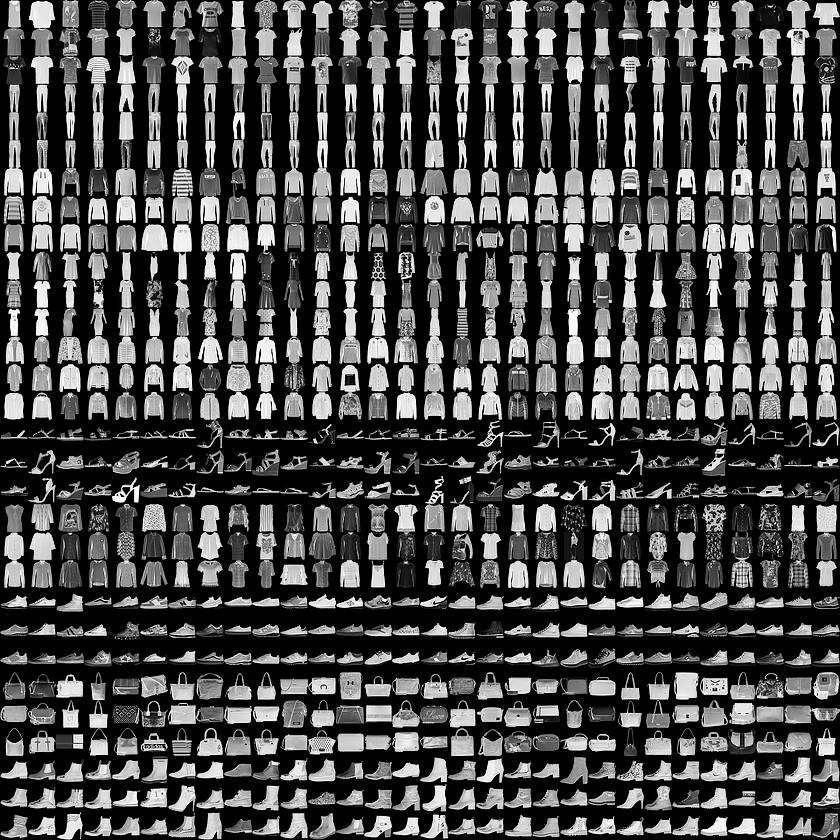使用神经网络工具TensorFlow训练FashionMNIST
数据集FashionMNIST
FashionMNIST 是一个替代 MNIST 手写数字集的图像数据集。 其涵盖了来自 10 种类别的共 7 万个不同商品的正面图片。
FashionMNIST 的大小、格式和训练集/测试集划分与原始的 MNIST 完全一致。60000/10000 的训练测试数据划分,28x28 的灰度图片。
加载数据集
-
网络加载数据集
fashion_mnist = keras.datasets.fashion_mnist (train_images, train_labels),(test_images, test_labels) = fashion_mnist.load_data() -
本地加载数据集
定义加载数据的函数,./datasets/fashion/为保存gz数据的文件夹,该文件夹下有4个文件
'train-labels-idx1-ubyte.gz',
'train-images-idx3-ubyte.gz',
't10k-labels-idx1-ubyte.gz',
't10k-images-idx3-ubyte.gz'def load_data(data_folder): files = [ 'train-labels-idx1-ubyte.gz', 'train-images-idx3-ubyte.gz', 't10k-labels-idx1-ubyte.gz', 't10k-images-idx3-ubyte.gz' ] paths = [] for fname in files: paths.append(os.path.join(data_folder, fname)) with gzip.open(paths[0], 'rb') as lbpath: y_train = np.frombuffer(lbpath.read(), np.uint8, offset=8) with gzip.open(paths[1], 'rb') as imgpath: x_train = np.frombuffer( imgpath.read(), np.uint8, offset=16).reshape(len(y_train), 28, 28) with gzip.open(paths[2], 'rb') as lbpath: y_test = np.frombuffer(lbpath.read(), np.uint8, offset=8) with gzip.open(paths[3], 'rb') as imgpath: x_test = np.frombuffer( imgpath.read(), np.uint8, offset=16).reshape(len(y_test), 28, 28) return (x_train, y_train), (x_test, y_test) (train_images, train_labels), (test_images, test_labels) = load_data('./datasets/fashion/') -
查看训练集的个数
print(train_images.shape) -
展示训练集内的某个图像
plt.imshow(train_images[0]) plt.show()
构建神经网络
- 简单神经网络添加flatten层、全连接层
- 卷积神经网络添加卷积层、池化层、flatten层和全连接层
- 全连接层最后输出10,分别对应FashionMNIST的10个类别
- 构建完成后可以使用
model.summary()预览神经网络的结构
-
构建简单的神经网络
model = keras.Sequential([ keras.layers.Flatten(input_shape=(28, 28)), keras.layers.Dense(128, activation=tf.nn.relu), keras.layers.Dense(10, activation=tf.nn.softmax) ])神经网络结构预览
(784+1)128=100480 (128+1)10=1290Model: "sequential" _________________________________________________________________ Layer (type) Output Shape Param # ================================================================= flatten (Flatten) (None, 784) 0 _________________________________________________________________ dense (Dense) (None, 128) 100480 _________________________________________________________________ dense_1 (Dense) (None, 10) 1290 ================================================================= Total params: 101,770 Trainable params: 101,770 Non-trainable params: 0 _________________________________________________________________ -
构建卷积神经网络
model = keras.Sequential([ keras.layers.Conv2D(64, (3, 3), activation='relu', input_shape=(28, 28, 1)), keras.layers.MaxPool2D((2, 2)), keras.layers.Conv2D(64, (3, 3), activation='relu'), keras.layers.MaxPool2D((2, 2)), keras.layers.Flatten(input_shape=(28, 28)), keras.layers.Dense(128, activation=tf.nn.relu), keras.layers.Dense(10, activation=tf.nn.softmax) ])卷积神经网络结构预览
Model: "sequential" _________________________________________________________________ Layer (type) Output Shape Param # ================================================================= conv2d (Conv2D) (None, 26, 26, 64) 640 _________________________________________________________________ max_pooling2d (MaxPooling2D) (None, 13, 13, 64) 0 _________________________________________________________________ conv2d_1 (Conv2D) (None, 11, 11, 64) 36928 _________________________________________________________________ max_pooling2d_1 (MaxPooling2 (None, 5, 5, 64) 0 _________________________________________________________________ flatten (Flatten) (None, 1600) 0 _________________________________________________________________ dense (Dense) (None, 128) 204928 _________________________________________________________________ dense_1 (Dense) (None, 10) 1290 ================================================================= Total params: 243,786 Trainable params: 243,786 Non-trainable params: 0 _________________________________________________________________
训练神经网络
训练模型,epoch设置训练次数,设置epoch为10,训练10组训练集
多分类问题loss函数使用交叉熵更为合适,优化策略使用Adam
train_images = train_images/255
model.compile(optimizer=tf.optimizers.Adam(),
loss=tf.losses.sparse_categorical_crossentropy,
metrics=['accuracy'])
model.fit(train_images.reshape(-1, 28, 28, 1), train_labels, epochs=10)测试模型
-
使用训练集测试模型的准确度
test_images_scaled = test_images/255 model.evaluate(test_images_scaled.reshape(-1, 28, 28, 1), test_labels)测试结果
#简单的神经网络
313/313 [==============================] - 0s 500us/step - loss: 0.3448 - accuracy: 0.8847
#卷积神经网络
313/313 [==============================] - 1s 3ms/step - loss: 0.2859 - accuracy: 0.9111 -
使用模型预测测试集的标签
预测测试集第一个图像的标签print(np.argmax(model.predict((test_images[0]/255).reshape(-1, 28, 28, 1))))测试结果:9
模型训练结果对比
简单的神经网络和卷积神经网络,损失函数loss和准确度对比
| Epoch | 简单的神经网络(loss/accuracy) | 卷积神经网络(loss/accuracy) |
|---|---|---|
| 1 | 0.4960/0.8269 | 0.4513/0.8354 |
| 2 | 0.3750/0.8658 | 0.3036/0.8893 |
| 3 | 0.3376/0.8771 | 0.2563/0.9050 |
| 4 | 0.3154/0.8840 | 0.2221/0.9174 |
| 5 | 0.2960/0.8920 | 0.1951/0.9274 |
| 6 | 0.2802/0.8958 | 0.1745/0.9354 |
| 7 | 0.2695/0.9002 | 0.1540/0.9430 |
| 8 | 0.2602/0.9028 | 0.1367/0.9492 |
| 9 | 0.2494/0.9062 | 0.1193/0.9543 |
| 10 | 0.2406/0.9097 | 0.1077/0.9593 |
由表格可以得出结论:
- 两个神经网络的训练结果都不错,loss函数的数值都在不断降低
- 卷积神经网络比简单的神经网络效果更好,证明一定情况下神经网络的宽度和深度更大的神经网络效果更好,但是所需的性能要求更高,训练的时间更长。
使用神经网络工具TensorFlow训练FashionMNIST Github完整代码
附录
代码使用的库文件
import numpy as np
import os
import gzip
import matplotlib.pyplot as plt
from tensorflow import keras
from tensorflow.keras import models
import tensorflow as tf


